Just like when we harvest an animal, when we harvest a tree, it is best to use every usable part. Tree bark has many incredible uses, many of which can help us survive in an emergency or help us thrive long term if we need to live without the common conveniences that we may be accustomed to.
There are some surprising uses for tree bark, from shelter and water proofing, transportation, heat, food, and medicine, as well as safety gear, all of which can be made from tree bark.
Sustainable Foraging
Even in a survival situation, and especially for recreational foraging and gaining practical wilderness survival skills, gathering tree bark should be undertaken conscientiously and sustainably. Where possible, harvest bark from pruned branches without damaging the tree trunk.
Taking bark from the full circumference of the tree trunk, also called girdling, will kill the tree. It is recommended to take no more than 1/3 of the circumference of a tree for the tree to survive. I would recommend taking even less, even in a dire life-threatening situation.
Identifying Tree Species
Possibly one of the most important bushcraft skills is plant identification, particularly if you plan on eating or consuming plant parts or using plant-based medicine. Learning the plants and trees that grow in your area can go a long way toward knowing how to use them in a survival situation.
A quick identification tip is determining the difference in evergreen conifer needles. Pine needles are long and grow in bundles of two, three, or five. Fir trees, including Douglas fir (which is not a true fir) have flat needles. Spruce trees generally have angular needles of three to four sides.
Food
We’re talking about eating tree bark here, so evidently, things aren’t going really great. There are edible tree barks, some more palatable than others. Some you can even eat raw and are pretty good, others you need to cook or dry, and ground into a flour and even of those, some are a reasonable food source and some will keep you alive in dire circumstances.
#1. Raw Tree Bark
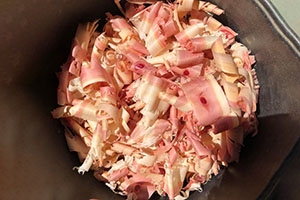 Barks that can be eaten raw include the inner bark of pine which is succulent and sweet when sap is flowing in spring.
Barks that can be eaten raw include the inner bark of pine which is succulent and sweet when sap is flowing in spring.
It can also be boiled. Eating too much of this might cause a bellyache so best to use some restraint.
The moist inner bark of cedar, larch (tamarack), balsam poplar, trembling aspen, alder, and maple, can be eaten fresh, and I would guess are probably also at their best in the spring.
#2. Dried Tree Bark
Tree inner barks that can be dried and ground into flour are beech, cedar, birch, willow, alder, and pine. For primarily survival use, the inner bark of hemlock, larch, and spruce can also be ground into a meal to extend the food supply.
#3. Cooked Tree Bark
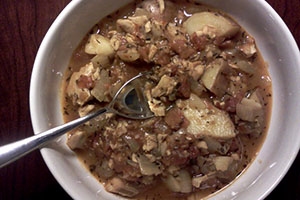 Barks that are best cooked are the inner barks of pine, birch, willow, alder, and maple.
Barks that are best cooked are the inner barks of pine, birch, willow, alder, and maple.
These can be added to soups and stews or cut into strips and used like spaghetti.
Related: Do You Recognize this Tree? [All Parts are Edible]
#4. Tree Bark Tea
Barks that make good tea are apple bark and birch bark tea. There are many more teas listed below in the medicinal tea section.
Shelter
#5. Bedding
Similarly, tree bark can be used to insulate the ground inside a shelter making it drier to sleep on and pounding bark fibers into fluffiness can create reasonable a mattress and blankets.
#6. Roofing Material
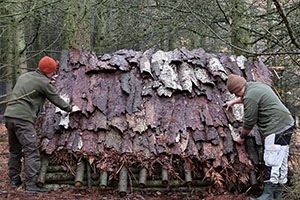 Bark has been protecting the tree for its lifetime so it only makes sense that using slabs of bark as tiles as an emergency or even long term roofing solution is an option and historically, bark has been used extensively for this purpose.
Bark has been protecting the tree for its lifetime so it only makes sense that using slabs of bark as tiles as an emergency or even long term roofing solution is an option and historically, bark has been used extensively for this purpose.
Sourcing bark from dead Douglas fir, birch, and cedar trees are good options.
#7. Insulation
Many bark fibers, particularly cedar, can be pounded into a fluff and used as an insulator for emergency shelters.
Clothing
#8. Belt
This might be dark, but in a serious survival situation, most of us will lose weight. We’re pigging out on pine bark after all. Using twisted or braided willow and cedar bark fibers could fashion a handy belt to keep your pants up or maybe a satchel strap, to help carry your foraged supplies. In survival, dual purpose takes on a whole new meaning.
Related: Survival Uses for Your Good Old Leather Belt
#9. Hat
Spending a considerable amount of time outside, a hat can go along way to keep you dry, warm, and protect you from the sun. Birch and cedar, when boiled, can become very pliable to form into a protective survival hat.
#10. Woven Fabric and Thread
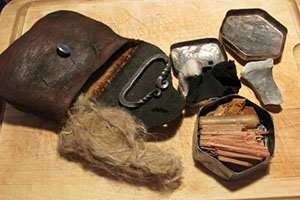 Historically, many people around the world have used bark to make clothing. Running around in the bush is hard on the body and skin, and fashioning durable, protective clothing or even armor can help get you through a rough day.
Historically, many people around the world have used bark to make clothing. Running around in the bush is hard on the body and skin, and fashioning durable, protective clothing or even armor can help get you through a rough day.
A combination of birch, cedar, willow, or other fibrous bark material taken in sheets, strips, or threads, can be twisted, heated, boiled or pounded into softness, and based on your skill level, can be sewn together so you can protect yourself from the elements.
#11. Sunglasses or Snow Goggles
If you have experienced snow blindness, it is agony, and sunburned eyes are not fun either. Protecting your eyes in a survival situation may be paramount. The Inuit of Northern Canada made snow goggles, sometimes from birch bark by carving the bark to fit around the eyes and making small slits in front of the eyes to see out of, so they could protect their vision from the sun glaring off the snow.
Medicine
#12. Wound Care: Bandages, Absorbent Dressings, and Cast Material
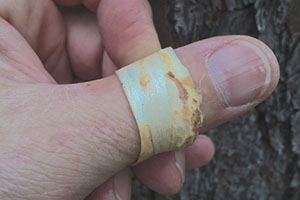
You can make a cast by boiling balsam poplar bark into a thick syrup that you can poor on cloth to make casting material for setting broken bones.
Also, the inner bark of pine can be used as dressing for burns, scalds, and infections, while the pounded fluffy material made from barks such as cedar may be used in bandages and absorbent dressing to staunch bleeding.
#13. Medicinal Teas
Making teas from tree bark to extract medicinal properties has been practiced for centuries. Each of us may like our tea stronger or weaker, hotter, or cooler, but a basic rule of thumb for bark tea would be 1 teaspoon of well-chopped bark to 1 cup of water, boiled for up to 10 minutes, and steeped for an additional 20 to 30 minutes.
Bark teas with analgesic properties are willow, trembling aspen, and red osier dogwood.
For respiratory and breathing issues you can try hemlock, larch, balsam poplar, and high-bush cranberry.
Bark teas to aid digestion and stomach problems are spruce, trembling aspen, and high-bush cranberry.
#14. Poultices
Wounds, cuts, scrapes, insect bites, slivers, inflammation, rashes, and ulcers are just a few skin mishaps that can cause discomfort and even become life threatening without proper healing and care. Some barks used as poultices, a moist mash of bark held in place with cloth, can help provide healing relief. These include inner bark of spruce, larch, balsam poplar, willow, alder, and hazelnut.
#15. Medicinal Washes
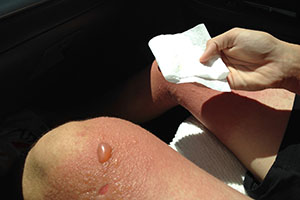 Cleaning wounds, burns, infections, bites, or other skin issues can help the healing process.
Cleaning wounds, burns, infections, bites, or other skin issues can help the healing process.
Medicinal washes, made the same way as a bark tea, may speed up recovery and minimize infection.
Boiled hemlock bark, alder bark tea, and oak bark tea are good options for wound cleaning.
#16. Dental Medicine
Chewing willow bark can clean teeth and prevent cavities while chewing oak bark can relieve toothache pain.
Food Growing, Gardening & Landscaping
#17. Weeds Control
Cedar bark mulch can inhibit growth in plants, as well as fungus and bacteria, so can be a clean way to keep an area free of weeds, pests, and disease, while also smelling wonderful.
#18. Healthy Soil
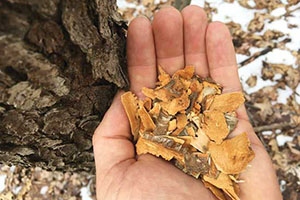
Douglas fir bark mulch lasts for a long time, retains its dark brown colors, and helps soil retain moisture.
It can be used close to trees, shrubs, flowers, and vegetable plantings.
Related: 6 Practical Uses for Autumn-Falling Leaves
#19. Root Growth
Willow bark tea contains a rooting hormone and can be used for watering seedlings as it will promote root growth.
Transportation
#20. Canoe
A tree bark canoe would be a master survivalists project combining bushcraft and master woodworking skills. Please keep in mind, in attempting a project of this scale, do not take bark from live trees as stripping more than 1/3 of the bark from a living tree will scar and probably kill the tree.
#21. Sled
Using the slippery, grainy sides of certain barks like white fir or paper birch can be used to make a sled for pulling heavy materials along smooth surfaces.
Tools and Accessories
#22. Mats
Woven mats can provide a clean area for cooking, sleeping, and working and can be made by twisting and weaving long bark fibers together.
#23. Baskets
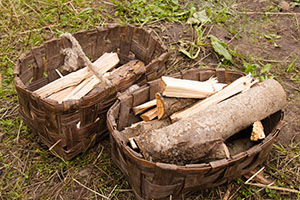 Baskets can be made from woven flexible strips of bark, or bark sheets formed into baskets or containers.
Baskets can be made from woven flexible strips of bark, or bark sheets formed into baskets or containers.
Willow, cedar, and birch are viable options, but certainly try to use what you have nearby.
Related: How to Store and Stack Firewood The Right Way
#24. Tree Bark Ropes
Rope and twine can be essential items with limitless uses in survival situations and many bark fibers twisted or braided can be made into rope or twine.
#25. Preservatives
Preservative and dyes for tanning hides and coloring wooden articles such as paddles can be made from the barks of hemlock and alder.
Knowing tree and shrub species and how to use their bark could save lives in a survival situation. Tree bark has a multitude of uses and by using our ingenuity and creativity, can help us survive and thrive.
You may also like:
 8 Cheap Protein Sources to Add to Your Stockpile Right Now
8 Cheap Protein Sources to Add to Your Stockpile Right Now
How to Make Bark Bread from a Tree that Grows on Almost Every Street in America (Video)

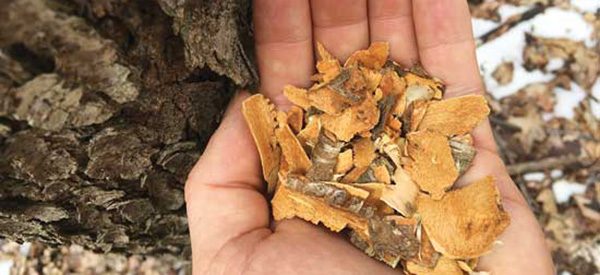




















Very helpful tips! Thank you!
Where are the instructions for crafting these items or for identifying trees and their bark, especially in winter? Great info, but some diagrams would help a lot. Thank you for posting all the great info you provide. I love reading survival skills and techniques.
Diloma: Best bet, get a book on it and study it. Every region has local names for things, often a half-dozen names. niio
Here’s how you can make some baskets from tree bark: https://www.youtube.com/watch?v=b7vl0LWauN0
Also,check this one for making tree bark ropes/cord:
https://www.youtube.com/watch?v=j_fMVs2J338
There are a lot of videos/ tutorials on how to make different things from tree bark.
Nothing says I love you like a hearty bowl of tree bark. ?
Ashe Juniper is a small cedar tree endemic to the hill country West of Austin. A little bird, the Golden Cheek Warbler, peels off strips of this tree’s outer bark to build its nest, nesting nowhere else in the world. The inner bark of Ashe Juniper, burned in the absence of oxygen, can be used to leaven biscuits and such pastry. You don’t have to learn everything about plants everywhere, just the plants around you. Who thinks of bark as useful? What a good article this is.
Thank you! I’m a tree fanatic from birth. Very good read. niio!
Not that it matters; but there are only 24 items listed, not 25. The article skips from item number 14 to item number 16, leaving out item 15, completely. Other than that, great info.
Bruce Parker, 15 is there, it is poultices from tree bark.